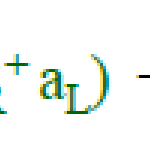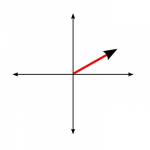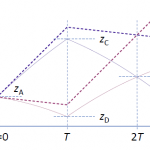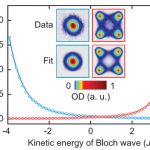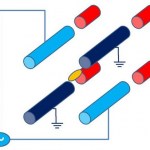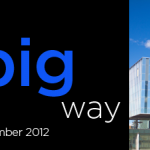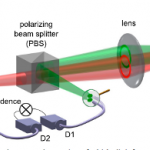Quantum Optics
One thing I left out of the making-of story about the squeezed state BEC paper last week happened a while after publication-- a few months to a year later. I don't quite recall when it was-- I vaguely think I was still at Yale, but I could be misremembering. It's kind of amusing, in an exceedingly geeky way, so I'll share it, though it's also a story of an embarrassing mis-step on my part.
So, the physical situation we were studying is described by the "Bose-Hubbard Hamiltonian": Bose because it's dealing with bosons (there's also a Fermi-Hubbard version, I believe); Hubbard after [mumble]…
I spend a lot of time promoting Rhett Allain's Dot Physics blog, enough that some people probably wonder if I get a cut of his royalties (I don't). I'm going to take issue with his latest, though, because he's decided to revive his quixotic campaign against photons, or at least teaching about photons early in the physics curriculum. We went through this back in 2008 and 2009 (though Rhett's old posts are linkrotted away, so you only get my side of the story...). I'm no more convinced this time around, even though he drags in Willis Lamb and David Norwood for support.
There are basically two…
Yesterday's write-up of my Science paper ended with a vague promise to deal some inside information about the experiment. So, here are some anecdotes that you would need to have been at Yale in 1999-2000 to pick up. We'll stick with the Q&A format for this, because why not?
Why don't we start with some background? How did you get involved in this project, anyway? I finished my Ph.D. work at NIST in early 1999, graduating at the end of May. I needed something to do after that, so I started looking for a post-doc by the don't-try-this-at-home method of emailing a half-dozen people I knew…
In Monday's post on squeezed states, I mentioned that I really liked the question because I had done work on the subject. This is, in fact, my claim to scientific fame (well, before the talking-to-the-dog thing, anyway)-- I'm the first author on a Science paper with more than 500 citations having to do with squeezed states. And since I've never written it up on the blog before, I'll leap on this opportunity to do some shameless self-promotion...
Well, aren't we Mr. Ego today? What's this paper that you're so impressed with about? I've never been all that good with titles, but I like to think…
In the Physics Blogging Request Thread the other day, I got a comment so good I could've planted it myself, from Rachel who asks:
It’s a term I see used a lot but don’t really know what it means – what is a “squeezed state”? What does “squeezing” mean? (in a QM context of course…)
I love this, not only because it gives me an excuse to talk about cool physics, but because it will let me engage in blatant self-promotion-- I have a Science paper on squeezed states, which I've never actually written up for the blog. So this post will be a great way to set up a future post, ResearchBlogging that…
I'm always a little ambivalent about writing up papers that have also been written up in Physics: on the one hand, they make a free PDF of the paper available, which allows me to reproduce figures from the paper in my post, since I'm not breaking a paywall to do it. Which makes it much more attractive to write these up. On the other hand, though, they do a pretty good job writing accessible descriptions, so there's not that much for me to add.
In the case of this paper, I'll write it up anyway (albeit somewhat more briefly than usual, because they already did a nice job), just because the…
A few months back, I got a call from a writer at a physics magazine, asking for comments on a controversy within AMO physics. I read a bunch of papers, and really didn't quite understand the problem; not so much the issue at stake, but why it was so heated. When I spoke to the writer (I'm going to avoid naming names as much as possible in this post, for obvious reasons; anyone I spoke to who reads this is welcome to self-identify in the comments), he didn't really get it, either, and after kicking it around for a while, it failed to resolve into a story for either of us-- in his case, because…
Hey, dude? Yeah, what's up?
I'm not normally the one who initiates this, but I was wondering: When you were at DAMOP last week, did you see any really neat physics? Oh, sure, tons of stuff. It was a little thinner than some past meetings-- a lot of the Usual Suspects didn't make the trip-- but there were some really good reports from a lot of groups.
Anything really surprising? Well, there was one talk that I really liked a lot, that I went to on a lark, because I didn't understand what the session title could possibly mean, and there was no abstract for the talk: Experimental Studies of…
There's been a bunch of talk recently about a poll on quantum interpretations that showed physicists badly divided between the various interpretations-- Copenhagen, Many-Worlds, etc.-- a result which isn't actually very surprising. Sean Carroll declares that the summary plot is "The Most Embarrassing Graph in Modern Physics, which I think is a bit of an overreaction, but not too much of one. I do strongly disagree with one thing he says in explaining this, though:
Not that we should be spending as much money trying to pinpoint a correct understanding of quantum mechanics as we do looking for…
Last week's post talked about the general idea of negative temperature, with reference to this much-talked-about Science paper (which also comes in a free arxiv version from which the figures used here are taken). I didn't go into the details of how they made a negative temperature gas, though, and as it's both very clever and hard to follow, I figure that deserves a post of its own.
Right, so last time you said that negative temperature just means you're more likely to find fast-moving atoms than slow ones, so all they need to do is whack these atoms in the right way? Right? No, it's more…
In which I unpack a cryptic paper title and explain how quantum superposition lets you use light to keep things from interacting with light.
-------------
I joined AAAS a couple of years ago to get a break on the registration fee for their meeting, and I've kept up the membership mostly because I like having individual access to Science articles, so I can read them in the coffee shops where I get actual work done. This also gives me access to articles in the "advance online publication" stage, which is hilarious because Union's institutional subscription doesn't include those articles-- if I'…
OK, it's a paper I mentioned here before, when it went up on the arxiv, but the "Comments on Atomic, Molecular, and Optical Physics" article I wrote this summer is up on the Physica Scripta web site now, and for the next not-quite-thirty days it's free to read and download:
Searching for new physics through atomic, molecular and optical precision measurements
We briefly review recent experiments in atomic, molecular and optical physics using precision measurements to search for physics beyond the Standard Model. We consider three main categories of experiments: searches for changes in…
It's a banner day for science explainer things I wrote, as a piece I wrote has just gone live at Tor.com:
Why Gandalf Is Wrong
Even as a kid, reading J. R. R. Tolkien’s The Lord of the Rings at the golden age of twelve or so, Gandalf’s response to Saruman never sat well with me. Splitting white light into its component colors is awesome, and taking things apart is the best way to learn how they work. Knowing how things work is the first step toward making them work better, a process that leads to the technologies that make modern life comfortable enough to, among other things, provide Oxford…
In which we do a little imaginary Q&A to explain the significance of Tuesday's Nobel Prize to Dave Wineland and Serge Haroche.
------------
I did a quick post Tuesday morning noting that the latest Nobel Prize in Physics was awarded to two big names from my corner of the field. This would've been a great time to drop a long explainer post about what they did and why it's cool, but alas, I have a day job, and the Nobel committee stubbornly refuses to tell me who they're giving the prizes to in advance. Oh, well.
Still, I'm just vain enough to think I can add something a little different…
The 2012 Nobel Prize in Physics was announced this morning, going to Serge Haroche and Dave Wineland, "for ground-breaking experimental methods that enable measuring and manipulation of individual quantum systems". This isn't a pair that was getting much love from the prognosticators, but they're an excellent choice. And, in fact, commenter KSC correctly picked Wineland in the betting pool and narrowly missed also getting Haroche.
Wineland has been on my mental list of people who ought to get a Nobel for a while, especially because he easily could've had a piece of the 1997 prize for laser…
In which we do a little ResearchBlogging to look at a new paper about weird quantum effects, entangling two photons that never both exist at the same time.
------------
I'm teaching full-time this term, but I've blocked out Thursdays as a day when I don't do class- or chair-related work. Usually, this means trying to write something on the work-in-progress, but I finished a short thing in the morning that needed to sit for a few hours before I looked at it again, which left a nice opportunity for some blogging. And, conveniently, somebody retweeted a New Scientist story about an arXiv…
Having been on hiatus for a couple of months has made me forget my obligation for self-promotion via the blog, but I should note one fast approaching public appearance: I'll be at the University of Waterloo next weekend, where they are celebrating the opening of their shiny new Quantum and Nano Center with an Open House on Saturday, September 29, featuring a bunch of public events. Two of these involve me: first, at 12:30 pm, my "What Every Dog Should Know About Quantum Physics" talk:
Chad Orzel, author of How to Teach Physics to Your Dog, will explore everything you — and your canine best…
In which we look at a slightly crazy-sounding proposal from my former boss, the experimental realization of which is getting close to completion.
------------
I spent more or less the entire first day of DAMOP a couple of weeks ago going to precision measurement talks. Most of these were relatively sedate (at least by the standards of a sub-field that routinely involves people proposing incredibly difficult experiments), but my boss when I was at Yale, Mark Kasevich, provided the bold proposals I usually expect, in this case suggesting an experiment using an atom interferometer to measure…
In which we do a little ResearchBlogging, taking a look at a slightly confusing paper putting a new twist on the double-slit experiment.
------------
I'm off to California this afternoon, spending the rest of the week at DAMOP in Pasadena (not presenting this year, just hanging out to see the coolest new stuff in Atomic, Molecular, and Optical Physics). I don't want to leave the blog with just a cute-kid video for the whole week, though, so here's some had-core physics: a new paper in the Proceedings of the National Academy of Sciences (freely available online), looking at a new sort of…
Enough slagging of beloved popularizers-- how about some hard-core physics. The second of three extremely cool papers published last week is this Nature Physics paper from the Zeilinger group in Vienna, producers of many awesome papers about quantum mechanics. Ordinarily, this would be a hard paper to write up, becase Nature Physics are utter bastards, but happily, it's freely available on the arxiv, and all comments and figures are based on that version.
You're just obsessed with Zeilinger, aren't you? All right, what have they done this time? The title is "Experimental delayed-choice…
